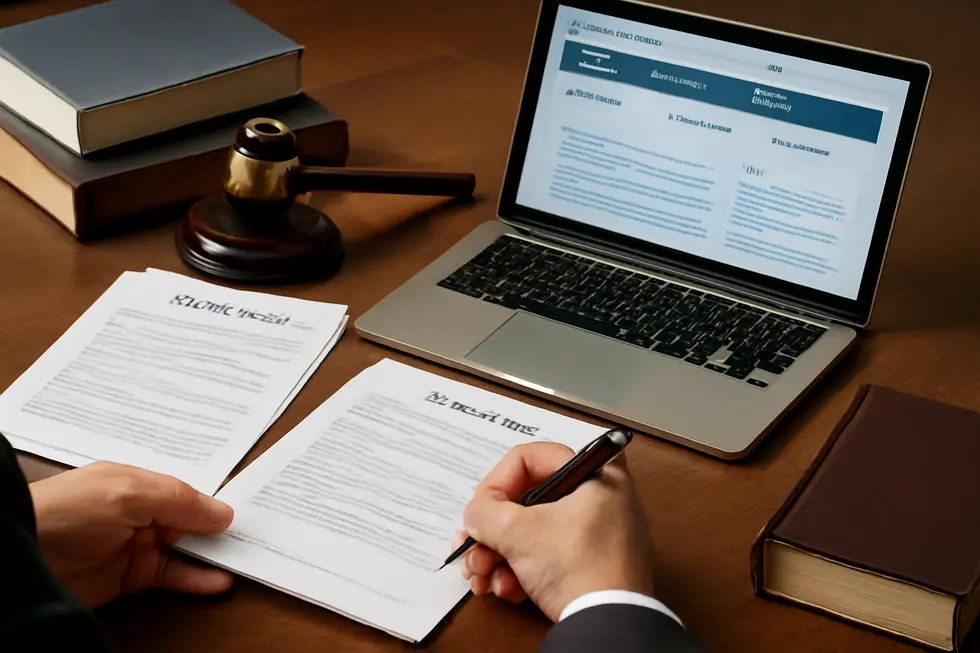Introduction
Intellectual property (IP) is a vital business asset that transforms ideas into exclusive, legally protected creations. For business owners, understanding how to use IP effectively can differentiate a brand, fuel growth, and secure competitive advantages. This guide reveals the essential steps to identify the types of IP your business generates, navigate the legal protections necessary for their security, and apply IP strategically to unlock new opportunities. You will discover how to enforce your rights against infringement, ensuring your business maintains its unique edge. Lastly, the guide explores how to leverage IP through licensing and partnerships, creating additional revenue streams and fostering collaboration. Together, these insights create a comprehensive framework for turning intellectual property into a core driver of business success.
Tables of Contents
Chapter 1: How to Use Intellectual Property: Understanding Types and Identification
- Mastering Patent Protection: Identifying and Safeguarding Technological Innovations
- Harnessing Trademark Identification and Brand Protection to Strengthen Your Intellectual Property Strategy
- Mastering Copyright and Intellectual Property Identification in Creative and Digital Works
- Safeguarding Trade Secrets: Integrating Confidential Information Protection into Your IP Strategy
- Harnessing Intellectual Property Through Targeted Identification and Strategic Business Alignment
Chapter 2: How to Use Intellectual Property: Legal Protection and Registration Processes
- Mastering Patent Protection: Securing and Registering Your Innovation’s Exclusive Rights
- Essential Steps and Strategies for Successful Trademark Registration
- Harnessing Copyright Protection: Registration and Legal Advantages in Intellectual Property Use
- Securing Trade Secrets: Comprehensive Measures for Legal Protection and Confidentiality
- Proactive Monitoring and Strategic Enforcement to Preserve Intellectual Property Value
Chapter 3: How to Use Intellectual Property: Strategic Application for Business and Innovation
- Uncovering and Evaluating Intellectual Property Assets to Strengthen Business Growth and Innovation
- Crafting an IP Strategy That Fuels Business Growth and Innovation Success
- Building a Cohesive IP Protection and Management Strategy to Enhance Business Growth
- Maximizing Commercial Impact: Transforming Intellectual Property into Business Growth and Innovation
- Systematic Documentation and Strategic Prioritization of Intellectual Property for Market Leadership
Chapter 4: How to Use Intellectual Property: Monitoring, Enforcement, and Defense Against Infringement
- Proactive IP Monitoring: Safeguarding Your Intellectual Assets Against Infringement
- Strategic Enforcement of Intellectual Property: Legal Actions and Remedies to Combat Infringement
- Effective Defense and Strategic Management of Intellectual Property to Thwart Infringement
- Harnessing AI and Digital Innovations for Proactive Intellectual Property Protection
- Harnessing Enforcement and Defense: Driving Economic Growth and Innovation through IP Protection
Chapter 5: Maximizing Intellectual Property Value Through Licensing and Strategic Partnerships
- Mastering IP Identification and Auditing to Unlock Licensing and Partnership Potential
- Crafting Effective Licensing Strategies to Maximize Intellectual Property Value
- Mastering Licensing Agreements: Crafting Clear Terms to Maximize Intellectual Property Value
- Maximizing IP Value through Strategic Partnerships and Collaborative Ventures
- Strategic Monitoring and Protection of Intellectual Property for Lasting Licensing Success
Chapter 1: How to Use Intellectual Property: Understanding Types and Identification

1. Mastering Patent Protection: Identifying and Safeguarding Technological Innovations
Using intellectual property effectively for technology requires recognizing inventions that are novel, useful, and non-obvious. This means focusing on products, processes, or improvements eligible for patent protection, such as AI algorithms, biotech advancements, or hardware designs. Maintaining confidentiality before filing is crucial to preserve novelty, so avoid public disclosures during development or collaborations. Filing patents early and strategically secures priority dates and allows claims to adapt as innovations evolve. Working with legal experts ensures claims cover present and future applications without losing enforceability. Once granted, patents provide exclusive rights to prevent unauthorized use and help recoup investments by attracting funding. Continuous monitoring and enforcement of these rights maintain competitive advantage. Staying informed about evolving patent laws ensures your strategy remains effective. For practical steps on managing technology patents, see guidance on patent filing strategies.
2. Harnessing Trademark Identification and Brand Protection to Strengthen Your Intellectual Property Strategy
Identifying and protecting your brand’s unique elements—names, logos, and slogans—is foundational to leveraging intellectual property for economic gain. Begin by conducting comprehensive trademark searches using databases like the USPTO’s TESS to avoid conflicts and ensure distinctiveness. Registering these trademarks provides legal exclusivity, preventing competitors from using confusingly similar marks and reinforcing consumer trust. This legal protection transforms brand assets into intangible economic value that can be licensed or franchised to fuel growth. Moreover, monitoring competitors’ trademark filings helps you anticipate market shifts and maintain a competitive edge. Combining trademarks with copyrights and trade secrets tailors protection to the nature of your assets, enhancing overall IP management. By strategically integrating trademark identification and protection, your intellectual property becomes a powerful tool to differentiate your business and unlock sustainable market advantages. For detailed trademark insights, consider exploring resources like trademark2go.com/company-trademarks-logos/.
3. Mastering Copyright and Intellectual Property Identification in Creative and Digital Works
Copyright is a cornerstone of intellectual property protection for creative and digital works. It safeguards original works fixed in a tangible medium—ranging from literary pieces, music, videos, to software and artwork—granting creators exclusive rights to reproduce, distribute, display, perform, and create derivatives. Alongside copyright, trademarks secure brand identifiers like logos and slogans, while patents cover inventions and processes, including software designs, albeit less commonly in creative contexts. Trade secrets protect confidential information through non-disclosure rather than registration. Creators often use licensing frameworks such as Creative Commons to clearly define permissible uses without relinquishing ownership. Identifying copyright hinges on originality, human authorship, and fixation, with registration enhancing enforceability. For effective protection and monetization, creators should combine registration, trademark safeguarding of branding elements, and strategic use of licenses. This integrated approach empowers creators to control and benefit from their intellectual assets within the digital realm. For insight on applying copyright in business, consider reviewing copyright details tailored for business owners.
4. Safeguarding Trade Secrets: Integrating Confidential Information Protection into Your IP Strategy
Effectively safeguarding trade secrets requires a multi-dimensional strategy combining legal, operational, and strategic actions. At its core, enforceable non-disclosure agreements (NDAs) with employees and partners establish a legal framework that defines confidential information and obligations surrounding its protection. Access to sensitive data must be tightly controlled via physical and digital security measures, with routine audits to demonstrate reasonable steps taken to maintain secrecy. Equally important is cultivating employee awareness through training, ensuring they understand the value and risks of mishandling trade secrets. Maintaining a detailed inventory documenting each secret’s nature, protection methods, and economic value facilitates enforcement and litigation readiness. Embedding these protections within a broader IP management plan enhances competitive positioning and business growth. Vigilance through monitoring and readiness to enforce rights deters misappropriation, especially as trade secrets gain increased significance amid limits on restrictive employment covenants. For a deeper dive on protecting intellectual assets, see comprehensive insights on company intellectual property protection.
5. Harnessing Intellectual Property Through Targeted Identification and Strategic Business Alignment
Harnessing Intellectual Property Through Targeted Identification and Strategic Business Alignment
Effective use of intellectual property begins with a thorough identification of all relevant assets—patents, trademarks, copyrights, and trade secrets—that underpin your innovations and brand. This detailed inventory enables businesses to align protection efforts with their core objectives, ensuring that IP safeguards support product uniqueness and market positioning. A well-crafted IP strategy integrates these protections into the broader business model, emphasizing international reach and timely registration to maximize exclusivity. Beyond protection, strategic management leverages IP to block competitors, open new licensing opportunities, and enhance brand value, transforming intangible assets into powerful growth drivers. Staying vigilant with enforcement and regular portfolio updates secures your competitive edge in evolving markets. For a deeper understanding of protecting brand elements like logos and names, consider exploring guidance on trademark protection for business names and logos.
Chapter 2: How to Use Intellectual Property: Legal Protection and Registration Processes

1. Mastering Patent Protection: Securing and Registering Your Innovation’s Exclusive Rights
A patent grants inventors exclusive rights to their new, useful, and non-obvious inventions for usually 20 years. This legal protection excludes others from making, using, or selling the invention without permission. To secure a patent, inventors must first clearly document their creation and conduct a prior art search to confirm its novelty. The registration process involves filing a detailed application with the patent office, defining the invention’s scope through claims, followed by examination where amendments may be required. Early filing can be protected via a provisional patent application, delaying full review but preserving the filing date. Once granted, maintaining patent rights requires active enforcement against infringement to sustain commercial value. Proper patent protection not only safeguards technical innovations but also creates opportunities to license or sell intellectual assets, fueling business growth and competitive advantage. For more insight on intellectual property types, visit the categories of intellectual property rights for business owners.
2. Essential Steps and Strategies for Successful Trademark Registration
Trademark registration is a crucial process in protecting your brand’s identity within the legal framework of intellectual property. Begin by conducting a comprehensive search using the USPTO’s Trademark Electronic Search System to ensure your mark—whether a name, logo, or slogan—is unique and not confusingly similar to existing trademarks. Preparing your application involves accurately defining your mark’s representation, the categories of goods or services, and your basis for filing, such as “use in commerce” or “intent to use.” Filing early is vital to secure priority and avoid disputes. Once submitted, actively monitor your application to address office actions or oppositions promptly. Although fees vary from $250 to $350 per class, and attorney assistance may cost between $500 and $2,000, professional guidance can improve success chances. Applying these steps strategically safeguards your trademark rights and maximizes your intellectual property’s commercial potential. For a detailed walkthrough, consider reviewing comprehensive resources on trademark protection for business names and logos.
3. Harnessing Copyright Protection: Registration and Legal Advantages in Intellectual Property Use
Copyright grants creators automatic protection from the moment their original work is fixed in a tangible form, such as writing, music, or art. However, registering your copyright with the U.S. Copyright Office elevates your legal standing, allowing you to enforce your rights more effectively. Registration is necessary before filing an infringement lawsuit, and when done within three months of publication, it permits recovery of statutory damages and attorney’s fees. The process involves submitting an application, a copy of the work, and fees, typically through a straightforward online system. Copyright shields the expression of ideas but not the ideas themselves, distinct from trademarks and patents protecting brands and inventions respectively. Leveraging registration solidifies your legal claims and enhances control over your intellectual creations, ensuring your rights are enforceable and your creative efforts are legally recognized. For practical guidance, explore detailed copyright information for business.
4. Securing Trade Secrets: Comprehensive Measures for Legal Protection and Confidentiality
Protecting trade secrets requires a thorough blend of legal, technical, and organizational measures to safeguard valuable confidential business information. Start by identifying and documenting your trade secrets clearly, creating a centralized inventory to support potential misappropriation claims. Implement robust internal security through encryption, access controls, and regular audits to prevent leaks or unauthorized access. Legal protections such as non-disclosure agreements (NDAs) and confidentiality clauses in employment contracts help bind parties to secrecy, while employee training fosters awareness of these obligations. Preparing for breaches with incident response plans and maintaining thorough documentation enables swift legal action if needed. Leveraging cybersecurity tools and complying with laws like the Defend Trade Secrets Act fortify these protections. This proactive, multi-layered strategy ensures your trade secrets remain secure and legally defensible, enhancing your intellectual property portfolio’s value. For more insights on intellectual property protections, see company intellectual property protection strategies.
5. Proactive Monitoring and Strategic Enforcement to Preserve Intellectual Property Value
Effective enforcement and monitoring of intellectual property are essential to safeguarding your legal rights and maintaining your competitive edge. Leveraging advanced digital tools powered by AI enables continuous surveillance across online platforms, detecting unauthorized use of trademarks, copyrights, or patents promptly. These technologies can automate targeted takedown notices while providing real-time analytics to inform strategic decisions. When infringement is identified, structured enforcement actions begin with issuing cease and desist letters, aiming to resolve disputes amicably or negotiate licensing. If violations persist, pursuing legal remedies such as injunctions and damages solidifies protection under relevant laws and international treaties. Strong enforcement integrates seamlessly with broader IP management by aligning responses with business goals, using well-documented claims and confidentiality measures. This blend of technology, legal action, and strategic oversight ensures your intellectual property retains its value and fosters innovation over time. For more insight on trademark enforcement, see detailed guidance on trademark protection for business names and logos.
Chapter 3: How to Use Intellectual Property: Strategic Application for Business and Innovation

1. Uncovering and Evaluating Intellectual Property Assets to Strengthen Business Growth and Innovation
Successfully leveraging intellectual property begins with a thorough assessment of what intangible assets exist within your business. This involves systematically identifying patents, trademarks, copyrights, trade secrets, and unique processes that may offer competitive advantage. Conducting an IP audit exposes valuable but overlooked assets, forming the foundation for strategic use. Equally important is the valuation of these rights through income, market, or cost-based approaches to understand their economic and strategic potential. Integrating this insight with clear, actionable IP goals allows businesses to protect and exploit their assets effectively. Such alignment with business vision ensures IP becomes a dynamic driver of revenue and innovation, rather than a mere legal formality. For more on trademark protections essential to brand identity, see detailed guidance on trademark protection for business name and logo.
2. Crafting an IP Strategy That Fuels Business Growth and Innovation Success
Creating an intellectual property (IP) strategy that truly supports business and innovation means integrating IP management closely with broader company goals. This involves prioritizing assets that strengthen competitive advantage, such as patents protecting core inventions or trademarks that differentiate the brand. Setting clear, measurable, and timely objectives ensures resources drive real outcomes aligned with market demands and growth plans. A dynamic IP roadmap connects protection efforts with product development milestones, making IP management proactive rather than reactive. Governance is key, so establishing cross-departmental collaboration—with legal, R&D, marketing, and finance working in concert—helps manage risks like infringement while optimizing asset value. Cultivating an organizational culture aware of IP’s importance further fuels innovation and safeguards creations. This holistic approach positions intellectual property as a critical, strategic lever for long-term business success. For deeper insights into brand protection through trademarks, explore this trademark protection resource.
3. Building a Cohesive IP Protection and Management Strategy to Enhance Business Growth
Effectively protecting and managing intellectual property rights is critical to securing competitive advantages and maximizing value. A cohesive IP strategy aligns legal protections—patents, trademarks, copyrights, and trade secrets—with business goals, enabling stronger market positions and growth opportunities. This involves establishing clear governance, regularly auditing IP assets, and defining ownership and licensing terms to avoid disputes in collaborations. Modern protections extend beyond registration to include cybersecurity, nondisclosure agreements, and strategic publishing, which guard against emerging threats like piracy and leaks. Innovative tools such as blockchain-based royalty systems offer flexible monetization and transparent management. Through careful stewardship of IP assets, businesses can unlock revenue streams via licensing and partnerships while safeguarding innovations. For guidance on protecting brand elements in particular, review the detailed insights on trademark protection.
4. Maximizing Commercial Impact: Transforming Intellectual Property into Business Growth and Innovation
Intellectual property serves as a pivotal asset that, when strategically managed, elevates business value and fuels innovation. To maximize this, companies begin with comprehensive IP audits, identifying patents, trademarks, copyrights, and trade secrets worth protecting. Securing legal rights through patents or nondisclosure agreements shields innovations from unauthorized use, while active enforcement preserves market advantage. Commercialization comes next: licensing IP to other firms generates revenue without direct operational costs, often enabling cross-licensing that opens access to complementary technologies and mitigates litigation. Beyond licensing, integrating patented technologies into new products or services directly expands market presence and company valuation. Collaboration with external partners, including universities via technology transfer, accelerates research and development. Aligning IP strategy with business goals ensures these assets support funding, partnerships, and sustained growth. This comprehensive approach transforms IP from static rights into dynamic tools driving commercial success and continuous innovation. For more insights on brand protection strategies, refer to trademark protection business name and logo.
5. Systematic Documentation and Strategic Prioritization of Intellectual Property for Market Leadership
Successful management of intellectual property (IP) requires meticulous documentation and strategic prioritization aligned with business goals. Regular IP audits uncover valuable patents, trademarks, copyrights, and trade secrets across the organization, while maintaining thorough records ensures legal enforceability and smooth administration. Prioritizing IP assets involves evaluating their impact on core technologies and market relevance to focus protection and investment where they deliver the greatest competitive advantage. Developing an adaptive IP roadmap synchronizes filings, registrations, and renewals with product development and innovation cycles. Effective IP management also demands clear contracts and compliance monitoring, especially when collaborating across departments or with external partners. By integrating legal oversight with commercial exploitation and enforcement, businesses secure sustainable growth and innovation leadership. For guidance on protecting brand elements like business names and logos, see trademark protection for businesses.
Chapter 4: How to Use Intellectual Property: Monitoring, Enforcement, and Defense Against Infringement

1. Proactive IP Monitoring: Safeguarding Your Intellectual Assets Against Infringement
Effective protection of intellectual property requires a proactive monitoring approach combining legal, digital, and market strategies. Ensuring timely registration and renewal of patents, trademarks, and copyrights forms the legal foundation, while internal safeguards like NDAs and employee agreements prevent leaks of sensitive information. Monitoring competitors’ filings and market activities helps spot potential infringements or gaps to strengthen your portfolio. Digital surveillance tools scan online platforms for unauthorized use, counterfeit distribution, or domain impersonation, securing your brand’s presence. Moreover, leveraging infringers’ own marketing against them can exert market pressure, often resolving conflicts without lengthy litigation. A layered strategy integrating these efforts not only detects violations early but preserves the commercial value of your IP, enabling confident enforcement and strategic growth. For deeper insights, explore detailed trademark protection guidance.
2. Strategic Enforcement of Intellectual Property: Legal Actions and Remedies to Combat Infringement
Enforcing intellectual property rights requires a strategic mix of legal tools and proactive monitoring. When infringement is detected, sending a cease and desist letter is often the first step to urge unauthorized users to stop immediately and avoid costly litigation. In some regions, administrative enforcement through local Intellectual Property Offices allows for faster resolution, including injunctions and fines, though monetary damages may be limited. Should disputes escalate, judicial enforcement through IP-specialized courts provides strong remedies such as injunctions to halt infringement, compensatory damages, and orders to destroy infringing goods. For online trademark violations, platform complaints can remove infringing content swiftly. Cross-border enforcement demands local counsel expertise to navigate differing laws effectively. Continuous market surveillance and alignment with business goals are essential to preserving IP value. For further insight into trademark enforcement, explore resources on trademark protection for business names and logos.
3. Effective Defense and Strategic Management of Intellectual Property to Thwart Infringement
Effectively defending intellectual property requires meticulous identification and timely registration of IP assets across jurisdictions to secure enforceable rights. Early legal engagement, such as issuing cease-and-desist letters or seeking injunctions, is vital to halt unauthorized use swiftly. Strategic management includes implementing robust internal policies and non-disclosure agreements to safeguard sensitive information, alongside vigilant market monitoring to detect infringements early. Defense tactics extend to differentiating your brand in the market and leveraging prior art to challenge unfounded claims. Legal remedies range from injunctions to monetary damages, with preemptive actions like declaratory judgments preventing costly disputes. Additionally, negotiating cross-licensing agreements can transform potential conflicts into collaborative opportunities. Continuous monitoring and appropriate enforcement ensure your IP remains a valuable, protected business asset. For deeper insights into trademark protection, explore this comprehensive guide on trademark protection for business name and logo.
4. Harnessing AI and Digital Innovations for Proactive Intellectual Property Protection
Leveraging AI-powered platforms and integrated IP management systems transforms how organizations monitor and enforce their intellectual property rights. These digital solutions automate complex tasks such as patent portfolio analytics, trademark infringement detection, and deadline tracking across global jurisdictions, enabling faster, more accurate oversight. Real-time scanning of online marketplaces and social media uncovers unauthorized use, helping IP owners swiftly initiate enforcement actions like takedown requests or cease-and-desist letters. By combining automated alerts with expert legal analysis, these technologies reduce manual effort and enhance strategic decision-making. This proactive approach mitigates risks, supports licensing opportunities, and maximizes IP value. For deeper insights into intellectual property protections on brand elements, explore this guide on trademark protection for business names and logos.
5. Harnessing Enforcement and Defense: Driving Economic Growth and Innovation through IP Protection
Effective enforcement and defense of intellectual property (IP) form the backbone of economic vitality and societal advancement. A strong IP strategy aligns legal protections with business objectives, enabling creators to deter infringement and maintain a competitive edge. Enforcement actions, supported by legal tools and technology, preserve the exclusivity of inventions, brands, and creative works, fostering innovation ecosystems that drive technological progress. Navigating territorial and exhaustion principles is essential to uphold rights internationally while adapting to digital-age challenges like cyber threats and piracy. Beyond protection, proactive IP management bolsters market fairness, safeguarding consumers and reinforcing brand trust. Financial instruments such as IP insurance further mitigate litigation risks, ensuring sustainable innovation investment. This integrated approach to IP defense not only secures individual assets but also fuels robust economic growth and collaborative global trade. For guidance on copyright protections that complement these strategies, see copyright information example for business.
Chapter 5: Maximizing Intellectual Property Value Through Licensing and Strategic Partnerships

1. Mastering IP Identification and Auditing to Unlock Licensing and Partnership Potential
Effectively leveraging intellectual property starts with a thorough identification and auditing process. This involves cataloguing all IP assets—patents, trademarks, copyrights, trade secrets—and evaluating their legal protections and commercial viability. A comprehensive IP audit reveals where protections may be incomplete and pinpoints assets with strong market or partnership appeal. Valuing these assets with methods like discounted cash flow or market comparisons helps clarify potential revenue sources. With this insight, you can craft targeted licensing strategies that define clear terms, compensation structures, and exclusivity to maximize returns. Moreover, well-audited IP forms the foundation for strategic partnerships or joint ventures, enabling collaboration and expansion without relinquishing ownership. Using IP as a market entry tool through regional licensing can further boost growth while retaining control. This integrated approach ensures your intellectual property is both safeguarded and strategically positioned to generate sustainable income and business opportunities. For detailed trademark considerations, see more on trademark protection for business names and logos.
2. Crafting Effective Licensing Strategies to Maximize Intellectual Property Value
Developing a successful licensing strategy is fundamental to transforming intellectual property (IP) into sustainable revenue streams. Begin by evaluating which IP assets—whether patents, trademarks, or copyrights—possess clear commercial value and are legally ready to license. Understanding your target markets is crucial; tailoring agreements to specific industries or geographic regions enhances impact. Draft precise licensing contracts detailing usage rights, royalty structures, and territorial limits to ensure enforceability and clarity. Selecting licensees aligned with your brand and capable of expanding market reach fosters productive partnerships. Protecting your IP through legal oversight prevents infringement and preserves value. Continuous monitoring of royalty income and market response allows optimization of your licensing program. Licensing also enables strategic partnerships and market entry with minimal risk while supporting innovation financing. For deeper insight, explore resources on trademark protection and licensing techniques at Trademark2Go.
3. Mastering Licensing Agreements: Crafting Clear Terms to Maximize Intellectual Property Value
Successfully negotiating and drafting licensing and partnership agreements requires precise definition of IP ownership, usage rights, payment structures, confidentiality, and exit strategies. Clearly stating whether IP is owned jointly or exclusively prevents future disputes and sets the foundation for collaboration. Usage rights must specify scope, duration, and geographic limits to align with business goals and protect market value. Compensation terms, such as royalties or flat fees, need to reflect the intended revenue model, whether passive income or expansion-driven. Confidentiality clauses safeguard trade secrets and sensitive information exchanged during partnership, ensuring continued protection. Including quality control provisions helps maintain brand reputation, while defining exit terms facilitates smooth transitions if the agreement ends. Balancing exclusivity encourages mutually beneficial growth without diluting IP value. Tailored agreements effectively integrate with broader strategies, helping to turn intellectual property into sustainable business assets. For foundational insights on trademark protections beneficial to these agreements, see trademark protection for business name and logo.
4. Maximizing IP Value through Strategic Partnerships and Collaborative Ventures
Maximizing revenue from intellectual property often hinges on smart collaboration through strategic partnerships and joint ventures. These alliances enable creators to extend their market reach and monetize IP without losing ownership. Licensing is a primary approach, granting usage rights under carefully negotiated terms that protect brand integrity while generating passive income. Joint ventures and co-development agreements pool resources to innovate and develop new products, often creating additional IP that requires clear ownership and revenue-sharing arrangements. Beyond traditional boundaries, ecosystem partnerships open channels across industries, leveraging complementary strengths to boost commercialization. Thoughtful IP allocation within partnerships and strategic use of licensing also facilitate entry into new markets with minimized risk. Particularly in emerging fields like AI, such collaborations accelerate innovation while safeguarding contributions and regulatory compliance. For deeper insights on forming effective partnerships for IP monetization, consider resources on licensing strategy.
5. Strategic Monitoring and Protection of Intellectual Property for Lasting Licensing Success
Effectively sustaining licensing revenue and partnerships demands a dynamic approach to intellectual property (IP) management that integrates real-time monitoring, portfolio optimization, and proactive protection. Deploying advanced technologies to scan patent landscapes enables early detection of competitor filings, uncovering potential licensing opportunities while reducing infringement risks. Coupling these insights with expert analysis ensures decisions align with business objectives and evolving legal frameworks. Establishing robust governance practices—including clear roles, regular IP audits, and budget allocation—supports disciplined portfolio management and compliance oversight. Monitoring licensee activities and enforcing agreements through automated tools preserves revenue streams and safeguards ownership. By upgrading to comprehensive IP management systems, organizations enhance efficiency, minimize errors, and strengthen strategic advantage. This integrated process transforms IP from a static asset into a thriving source of sustainable revenue and collaboration, deeply supporting innovation and growth.
Final thoughts
Effectively using intellectual property requires deliberate identification, securing robust legal protection, and employing strategic management to maximize its value. As a business owner, understanding the nuances of various IP types helps you safeguard your innovations and brand assets. Registering your IP formalizes your rights and enables enforcement against unauthorized use, preserving your competitive edge. Beyond protection, applying IP strategically fuels business growth, attracts investment, and expands market opportunities. Continuous monitoring and vigorous enforcement are crucial defenses that ensure your exclusivity remains intact in today’s competitive environment. Finally, embracing licensing and partnerships transforms IP from a static asset into a dynamic revenue generator. Mastering these facets of intellectual property turns what once were just ideas into formidable business advantages that support long-term success.
Your IP is the foundation of your success – let’s protect it together before it’s too late. We can’t wait to help you turn your ideas into legally secured assets.
About us
undefined


